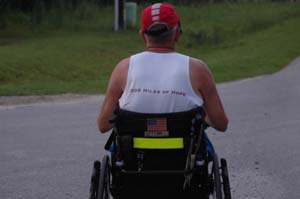Summer 2011 has been blistering. Even before summer got here.
For folks with certain disabilities or using certain medicines, the heat is a bear! Training in the heat is a bear, too. For example, high SCIs, such as myself, don’t sweat. Working out in the sun and in the heat is double jeopardy. I’ve observed other quads' techniques for coping with the heat and I’ve come up with a few of my own. Most of them involve water. Here are my helpful hints for quads training in the heat. Some may may be used by able-bodied athletes, too.
1) Training is the worst activity. You’re generally out there on the road for long periods with no support. My friend GM once suggested that I do my most intensive workouts in cooler (and colder) weather and just try to moderate and maintain during the hot months. I have started working out in the early AM, about 0540, before going to work and making no attempt to work out in the evening. I have actually extended my daily target workout to 10 miles. I remember doing this last year (with 10K target workouts) and was pleasantly surprised to find that it worked. As soon as cooler weather came in the fall, my energy level picked up immediately as did my endurance and my distances.
2) Get wet. In races when I am going all-out, I overheat even on cooler days. I ask the water stop volunteers to pour a cup of water on top of my helmet or throw a cup of water into my face (just make sure you're at the water table, not the energy drink table). Even if the heat doesn’t cause me to overheat, it still robs me of my energy and makes me lethargic. Many bike races that have a quad division will provide sag riders who will administer cooling water to quads. I almost always go through sprinkler stations in races and I look for lawn sprinklers that overspray the street when I workout. The Beaufort Road Race in July is the hottest race I do. I tell the Boy Scouts on one particular corner to let me have it with the water hose when I come by. My teammate said the kids’ enthusiasm was a little overzealous when other runners came through behind me and unexpectedly got the same treatment.
3) Seek shade.
The biggest advantage of working out early in the day is that you avoid the sun more so than avoiding the temperature. By about 10 AM, most of the shade is gone. I have even gotten up at 0330 to put in a long workout in the dark. Morning works better than the evening because the bugs aren’t as bad. Even in the early AM, I can still overheat. One recent morning, even though the air temperature was 77 when I started my workout, by 0715 when I finished, I measured my body temperature at 103 degrees!
4) Chill out. I like to eat an icy-pop right after a hot workout to recover more quickly. A rag soaked with cold water and Sea Breeze feels good too. The alcohol in the Sea Breeze also aids in cooling. I have eaten those frozen icy drinks at Dairy Queen that normally give you brain-freeze…without getting the brain-freeze.
5) Take water.
I take a thermos tank that I have modified with two tubes that go to the bottom of the tank. I had to modify the tank to make it airtight too. The tubes go to my helmet. One goes to my mouth. The other goes to the top of my head. I can suck on the mouthpiece a get a cool drink. I can blow into the tube and force cold water up to the top of my head. I also suck up a mouthful of water and squirt it out my lips onto my legs and shoulders. And yes, I'm the geekiest guy on the course...
6) Take ice.
I also have some fabric tubes made of nylon fabric that I have my teammate fill with ice. We tie them around my neck and they keep me cool for about an hour. As the ice melts, it wets me thoroughly, prolonging the cooling.
7) Take cover. Your head is the most sensitive part of your body to the sun's heat. Wear a runner's cap made of breathable polyester fabric. Preferably white. Likewise for your clothes. The coolest shirts I've found are lightweight polyester made of an open-knit fabric. Wal-Mart Sells them for 8 bucks. Brooks Running sells them for $40. When you run through a water station in a race, drink the energy drink (for hydration, fuel, and electrolytes) and pour the cup of water inside your cap.
8) Work out with a partner. You may not think clearly when you overheat. Let your partner know that.
Don’t forget to visit our donation site and support Hope For The Warriors. Make a donation and support this great cause!
Tuesday, June 14, 2011
Subscribe to:
Posts (Atom)







